MiCA Regulation: EBA's Guidelines on Data Reporting
The Regulation on Markets in Crypto-Assets (MiCA), Regulation (EU) 2023/1114, is crucial for the EU's regulatory approach. On July 15, 2024, the EBA released draft guidelines for data reporting by NCAs, issuers of asset-referenced tokens, e-money tokens, and Crypto-Asset Service Providers.

The evolving landscape of crypto-assets necessitates robust regulatory frameworks to ensure market integrity, consumer protection, and financial stability. The Regulation on Markets in Crypto-Assets (MiCA), formally known as Regulation (EU) 2023/1114, is a cornerstone of the European Union's approach to crypto-asset regulation. MiCA aims to establish a unified regulatory framework across Member States. On July 15, 2024, the European Banking Authority (EBA) issued a consultation paper outlining draft guidelines for data reporting by National Competent Authorities (NCAs), issuers of asset-referenced tokens (ARTs), e-money tokens (EMTs), and Crypto-Asset Service Providers (CASPs). This article provides a comprehensive analysis of these guidelines, their implications, and the next steps in the consultation process.
Source
[1]

[2]

Overview of MiCA Regulation
MiCA is designed to regulate the issuance and provision of services related to crypto-assets in the European Union. It covers various types of crypto-assets, including ARTs and EMTs. The regulation is divided into several titles, with Titles III and IV focusing on the specific requirements for ARTs and EMTs, respectively. These requirements encompass authorization, governance, disclosure, and operational aspects to ensure a secure and transparent market environment.
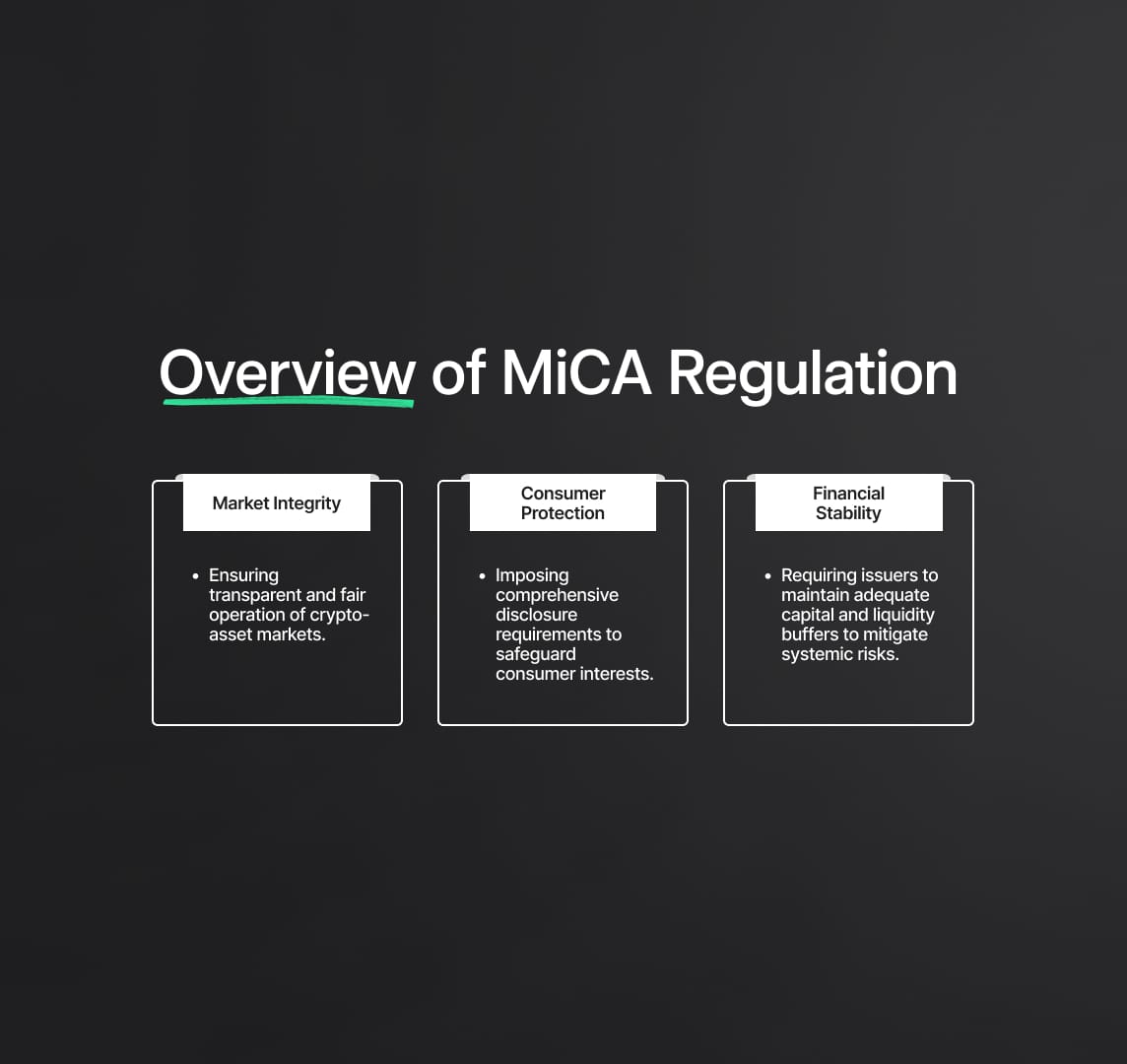
Key Objectives of MiCA
Market Integrity
One of the primary objectives of MiCA is to ensure that crypto-asset markets operate transparently and fairly. This includes implementing stringent measures to prevent market manipulation, insider trading, and other fraudulent activities. The regulation mandates detailed disclosure requirements and robust governance frameworks for issuers of ARTs and EMTs, promoting transparency and accountability within the market.
Consumer Protection
Protecting consumers from the inherent risks associated with crypto-assets is another critical objective of MiCA. The regulation imposes comprehensive disclosure requirements on issuers to ensure that consumers are well-informed about the risks and characteristics of the crypto-assets they invest in. Additionally, MiCA sets out stringent conduct and prudential requirements for issuers and service providers, aimed at safeguarding consumer interests.
Financial Stability
MiCA aims to address potential threats to financial stability posed by the rapidly growing crypto-asset market. The regulation requires issuers of ARTs and EMTs to maintain adequate capital and liquidity buffers to mitigate the risk of insolvency and ensure the smooth functioning of the market. By setting out clear regulatory requirements, MiCA helps to prevent systemic risks and promote stability within the financial system.
Regulatory Harmonisation
A key goal of MiCA is to create a unified regulatory framework across all EU Member States. This harmonization ensures that crypto-asset markets operate under a consistent set of rules, facilitating cross-border activities and enhancing market efficiency. By eliminating regulatory arbitrage and ensuring a level playing field, MiCA fosters a more integrated and competitive market environment.
Detailed Technical Aspects
MiCA establishes a comprehensive authorisation regime for issuers of ARTs and EMTs, requiring them to obtain prior approval from the relevant National Competent Authorities (NCAs). The authorisation process involves a thorough assessment of the issuer's business model, governance structure, risk management frameworks, and financial resources. NCAs are tasked with ongoing supervision to ensure continuous compliance with MiCA requirements.
Governance and Risk Management
The regulation mandates robust governance frameworks for issuers, including requirements for board composition, internal control mechanisms, and risk management policies. Issuers must implement effective risk management systems to identify, assess, and mitigate risks associated with their crypto-asset activities. This includes maintaining adequate capital and liquidity buffers, conducting regular stress testing, and having contingency plans in place.
Disclosure and Transparency
MiCA imposes extensive disclosure requirements on issuers of ARTs and EMTs. Issuers must provide detailed information about the crypto-asset, including its characteristics, underlying assets, risk factors, and the issuer's financial condition. This information must be disclosed in a clear and comprehensible manner, ensuring that consumers can make informed investment decisions.
Prudential Requirements
To ensure financial resilience, MiCA sets out prudential requirements for issuers, including minimum capital and liquidity thresholds. Issuers of ARTs must maintain a reserve of assets that fully cover the value of the issued tokens, while issuers of EMTs are required to hold an equivalent amount of fiat currency. These prudential requirements help to mitigate the risk of insolvency and ensure the stability of the crypto-asset market.
Data Reporting and Transparency
The EBA's guidelines on data reporting are integral to MiCA's framework, providing detailed instructions for NCAs and issuers on the content, format, and frequency of data submissions. The guidelines ensure that all relevant information is collected systematically, facilitating effective supervision and oversight by NCAs and the EBA.
EBA’s Guidelines for Data Reporting
The EBA’s consultation paper provides detailed guidelines on the templates and formats that National Competent Authorities (NCAs), issuers of Asset-Referenced Tokens (ARTs), E-Money Tokens (EMTs), and Crypto-Asset Service Providers (CASPs) should use to report data under MiCAR. These guidelines are crucial for maintaining consistent supervisory practices across the EU and ensuring that the EBA can effectively exercise its oversight functions.
Scope and Applicability
The draft guidelines are intended for:
- Member State Competent Authorities (NCAs): Defined under Article 3(1) point (35) of MiCAR. NCAs are the primary regulatory bodies within each EU Member State responsible for supervising the compliance of crypto-asset issuers and service providers with MiCA.
- Issuers of Asset-Referenced Tokens (ARTs): Entities that issue tokens linked to the value of multiple assets, such as fiat currencies, commodities, or a combination thereof.
- Issuers of E-Money Tokens (EMTs): Entities that issue tokens representing fiat currencies, designed to function similarly to electronic money.
- Crypto-Asset Service Providers (CASPs): Entities that provide various services related to crypto-assets, including custody, trading, exchange, and advisory services.
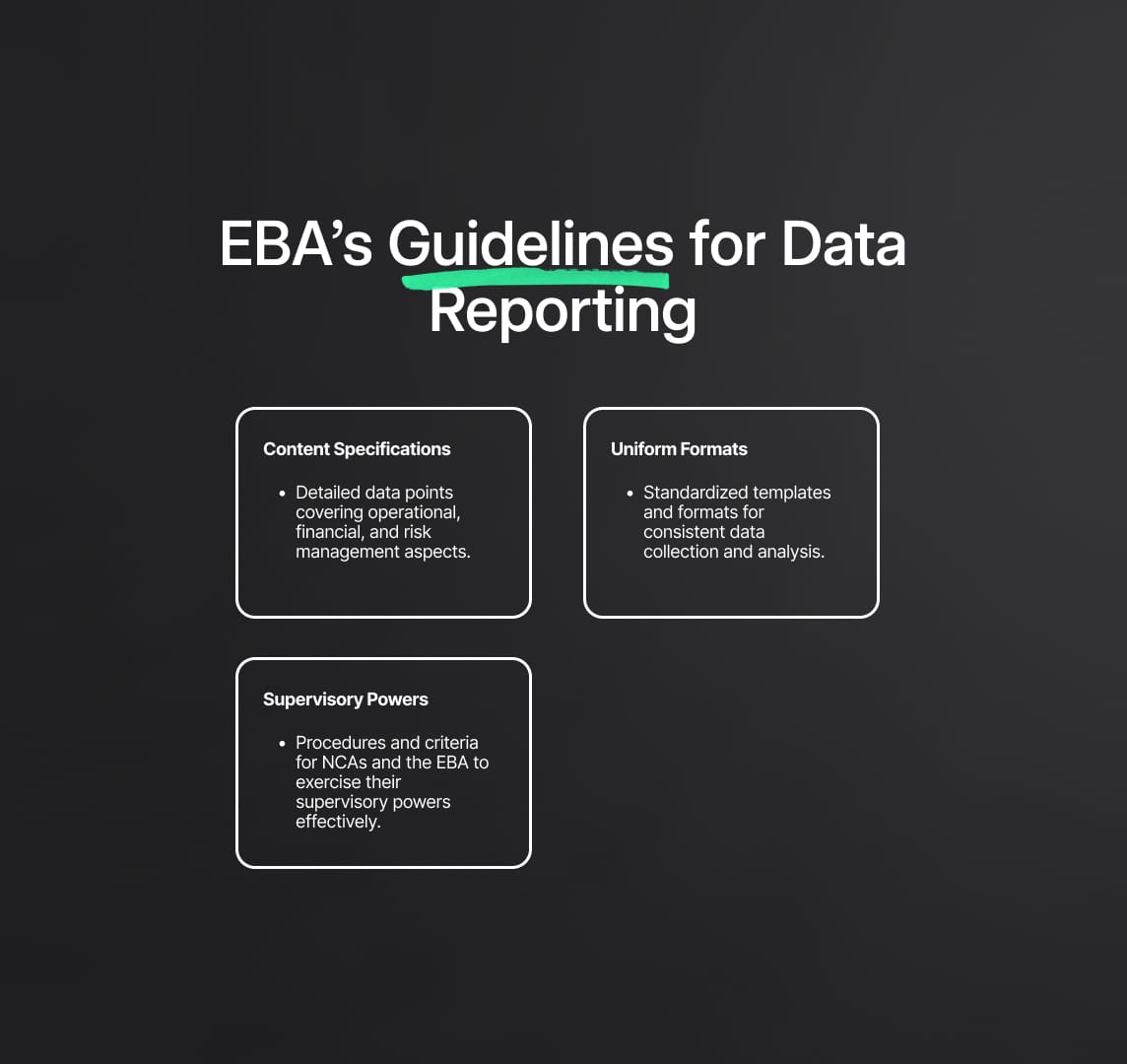
Key Components of the Draft Guidelines
The EBA’s draft guidelines encompass several key components designed to standardize and enhance the data reporting processes across Member States:
Content Specifications
The guidelines specify the exact content that NCAs and issuers need to report, ensuring that the information is comprehensive and relevant for supervisory purposes. This includes detailed data points covering various operational, financial, and risk management aspects of the entities involved.
Uniform Formats
To ensure uniformity and comparability of data across different Member States, the guidelines provide standardised templates and formats for reporting. This facilitates consistent data collection and analysis, enabling the EBA and NCAs to effectively monitor and compare the performance and compliance of different entities.
Supervisory Powers
The guidelines outline the procedures and criteria for NCAs and the EBA to exercise their supervisory powers under Articles 94(1)(a) and 122 of MiCAR. This includes the authority to request additional information, conduct inspections, and enforce compliance measures to ensure that issuers and service providers adhere to the regulatory requirements.
Reporting Requirements
The EBA’s draft guidelines detail specific reporting requirements for NCAs, issuers of ARTs and EMTs, and CASPs. These requirements are essential for maintaining transparency, enhancing market integrity, and protecting consumers.
For NCAs
NCAs are required to submit detailed information on various aspects of issuers' compliance with MiCAR. This includes:
- Governance and Internal Controls: NCAs must report on the governance structures and internal control mechanisms of issuers, ensuring that they have robust systems in place to manage risks and comply with regulatory standards.
- Financial Information: Comprehensive financial data, including balance sheets, income statements, and other relevant financial metrics, must be reported to provide a clear picture of the issuers’ financial health.
- Risk Management: Information on the risk management frameworks and practices of issuers must be included to assess their ability to identify, measure, and mitigate risks associated with their crypto-asset activities.
- Operational Resilience: Data on the measures taken by issuers to ensure operational continuity and resilience, such as business continuity plans and disaster recovery protocols, must be provided.
For Issuers of ARTs and EMTs
Issuers must ensure compliance with the detailed reporting requirements set out by NCAs. This involves:
- Governance and Internal Controls: Issuers must provide detailed information on their governance structures and internal control mechanisms, demonstrating their capability to manage operations effectively and in compliance with MiCAR.
- Financial Information: Issuers are required to submit comprehensive financial data, including details on assets, liabilities, income, and expenditures, to ensure transparency and financial accountability.
- Risk Management: Detailed descriptions of the risk management practices employed by issuers, including risk assessment methodologies and mitigation strategies, must be reported.
- Operational Resilience: Issuers must report on the measures implemented to ensure operational continuity and resilience, highlighting their preparedness for potential disruptions and their ability to maintain critical functions.
For CASPs
CASPs must provide relevant data to issuers to facilitate compliance with the reporting requirements. This cooperation is crucial for ensuring the completeness and accuracy of the reported information. CASPs are required to report on:
- Transaction Data: Detailed records of all transactions processed, including the volume, value, and nature of transactions, must be maintained and reported.
- Client Information: CASPs must report on the number and type of clients they serve, including details on client onboarding processes and due diligence measures.
- Asset Holdings: Information on the assets held in custody on behalf of clients, including the types and amounts of crypto-assets, must be reported to ensure transparency and accountability.
- Operational Data: CASPs must provide data on their operational activities, including information on system performance, security incidents, and compliance with regulatory requirements.
Reporting Instructions under MiCA Regulation
The MiCA Regulation (Regulation (EU) 2023/1114) necessitates comprehensive and systematic data reporting to ensure transparency, market integrity, and consumer protection within the crypto-asset sector. The European Banking Authority (EBA) has outlined specific guidelines to standardize this reporting process across the EU. These detailed reporting instructions are crucial for ensuring clarity and consistency in data submission by National Competent Authorities (NCAs), issuers of Asset-Referenced Tokens (ARTs), E-Money Tokens (EMTs), and Crypto-Asset Service Providers (CASPs). This section delves into the technical details of the reporting templates provided by the EBA, enhancing the overall regulatory framework of MiCA.
Template U 01.00: Number of Holders – EMT Referencing to EU Currency
Objective: This template aims to report the number of holders of e-money tokens, categorizing them by custodial and non-custodial wallets and further breaking them down into retail holders. This categorization helps in assessing the distribution and usage of e-money tokens among different types of holders.
Data Points:
- Total number of holders: The aggregate number of holders of e-money tokens.
- Holders of custodial wallets (including retail): The number of holders who store their tokens in custodial wallets, with a specific focus on retail holders.
- Holders of non-custodial wallets (including retail): The number of holders who store their tokens in non-custodial wallets, also detailing retail holders.
Template U 02.00: Value of the Token Issued and the Size and Composition of the Reserve of Assets
Objective: This template reports the value of the token issued and the size of the related reserve of assets, providing a clear picture of the financial backing and liquidity of the tokens.
Data Points:
- Aggregated value of the token issued: The total value of tokens issued within the reporting period.
- Maximum, average, and minimum values: These values offer insight into the fluctuations in the value of tokens issued over time.
- Size of the reserve of assets: Details the assets held in reserve to back the issued tokens, ensuring financial stability and consumer protection.
Template U 03.01: Composition of the Reserve of Assets by Type of Assets
Objective: This template details the composition of the reserve of assets, categorized by asset types and maturities. This information is essential for understanding the liquidity and risk profile of the reserve assets.
Data Points:
- Market value of asset categories: Includes deposits, commodities, government bonds, and other highly liquid financial instruments.
- Maturities: Information on the maturity profiles of these assets, which is crucial for liquidity management and risk assessment.
Template U 03.02: Composition of the Reserve of Assets by Counterparty/Issuer
Objective: This template reports the concentration by counterparties for each asset type within the reserve of assets, highlighting potential concentration risks.
Data Points:
- Names of the top twenty counterparties: Identifies major counterparties involved.
- Type of institution: Classifies the counterparties (e.g., banks, financial institutions).
- Amount/market value: The value of assets held with each counterparty.
- Percentage of total assets: The proportion of total reserve assets held with each counterparty.
Template U 04.01: Transactions Per Day – EMT Referencing to EU Currency
Objective: This template reports the average number and aggregate value of transactions per day during the reporting period, providing insight into the daily transaction volume and activity.
Data Points:
- Transactions within the country: Number and value of domestic transactions.
- Received transactions to the country: Inbound transactions.
- Sent transactions from the country: Outbound transactions.
Template U 05.01: Own Funds
Objective: This template focuses on reporting own funds related information on the token in scope of the reporting, ensuring issuers maintain adequate capital buffers.
Data Points:
- Minimum own funds requirements: The required minimum capital.
- Average reserve of assets: The average value of assets held in reserve.
- Fixed overheads: Operational costs that must be covered.
- Own funds amount: The total own funds available.
- Additional requirements: Any additional capital requirements specified by the regulation.
Template U 06.00: Maturity Ladder of the Reserve of Assets
Objective: This template reports the maturity structure of the reserve of assets, helping to assess liquidity risk and the issuer's ability to meet short-term obligations.
Data Points:
- Residual contractual maturity of assets inflows and outflows: Categorized across twelve time-buckets to provide a detailed maturity profile.
Template U 07.01: Additional Information for Significance Assessment
Objective: This template provides necessary information for the significance assessment following Article 43 of MiCA, determining whether an issuer qualifies as significant under MiCA criteria.
Data Points:
- Market capitalization: Total market value of the issuer's outstanding tokens.
- Issuer designation as 'gatekeeper': Whether the issuer holds a dominant market position.
- Issuance of other ART or EMT: Involvement in issuing additional tokens.
- Provision of crypto-asset services: Any additional crypto-asset related services offered by the issuer.
Template U 08.00: Information on Holders
Objective: Provide necessary information on the holders to issuers, enabling accurate calculation of the number of holders.
Columns:
- Name: Full name for natural persons, official registered name for legal persons.
- Code: Unique identifier such as national ID number or LEI.
- Type of Code: Type of identifier used (e.g., national ID, tax number, passport number).
- Retail/Non-Retail: Classification of the holder.
- Country: Country of residence or registered office.
Rows: Each row represents a specific holder.
Template U 09.01: Information on Transactions per Country
Objective: Report total number and aggregate value of transactions during the reporting period.
Columns:
- Number: Total number of transactions during the reporting period.
- Amount: Total aggregate value of transactions during the reporting period.
Rows:
- Total Transactions: Overall transactions within the reporting country.
- Made Within the Country: Transactions where both originator and beneficiary are within the country.
- Received Transactions: Transactions where the beneficiary is within the country, but the originator is outside.
- Sent Transactions: Transactions where the originator is within the country, but the beneficiary is outside.
Template U 09.02: Information on Transactions within the EU
Objective: Similar to U 09.01, but focused on transactions involving EU countries.
Template U 09.03: Distributed Ledger Addresses
Objective: Public ledger addresses used by CASPs for client transfers.
Columns:
- Distributed Ledger Address: Public ledger addresses used by CASPs for client transfers.
Rows: Each row represents a specific distributed ledger address.
Template U 09.04: Transactions Inflow and Outflow to/from the EU
Objective: Report transactions associated with inflows and outflows to/from the EU.
Columns:
- Number: Total number of transactions.
- Amount: Total aggregate value of transactions.
Rows:
- Inflow to the EU: Transactions where the payee is in the EU and the payer is outside.
- Outflow from the EU: Transactions where the payer is in the EU and the payee is outside.
Template U 10.00: Information on Token
Objective: Provide information on the number and amount of tokens held by CASPs, specifying those held by EU customers.
Columns:
- Number: Number of tokens held by CASPs.
- Amount: Amount of tokens held by CASPs, determined by specified valuation methods.
Rows:
- Tokens Held by CASP: Overall tokens held.
- Held via EU Customers: Tokens held by EU customers.
Data Point Model (DPM) and Validation Rules
The European Banking Authority (EBA)'s guidelines on the Data Point Model (DPM) and validation rules are critical for ensuring the accuracy, consistency, and high quality of data reported by institutions and Competent Authorities (CAs) under the MiCA Regulation. These guidelines are designed to provide a structured representation of all data items and enforce validation rules that guarantee the logical relationships and accuracy of reported data. This section delves into the technical details of the DPM and validation rules, emphasizing their importance in maintaining the integrity of the reporting framework under MiCA.
Single Data Point Model (DPM)
The Single Data Point Model (DPM) is a comprehensive framework that organizes data items into a structured and logical format, facilitating uniform data reporting across the European Union. The DPM is designed to ensure that all reported data is consistent, comparable, and easily accessible for analysis and supervision.
Key Criteria for DPM
- Structured Representation: The DPM provides a well-organized representation of all data items, ensuring that data is systematically arranged and easily interpretable. This structured approach aids in the efficient processing and analysis of data.
- Business Concepts Identification: The DPM identifies all relevant business concepts, ensuring that each data point is clearly defined and associated with specific business activities or regulatory requirements. This helps in maintaining clarity and relevance in data reporting.
- Data Dictionary: The DPM includes a comprehensive data dictionary that provides detailed descriptions of all data items. This dictionary includes labels and metrics for various data points, ensuring that all stakeholders have a clear understanding of the data being reported.
- Technical Specifications: The DPM contains all necessary technical specifications required for developing IT reporting solutions. This includes the structure of data tables, relationships between data points, and technical guidelines for data submission.
Example of DPM Structure
- Table Labels: Identifies different tables in the data model, each representing a specific aspect of reporting.
- Ordinate Labels: Represents the vertical dimension of the table, typically used for data categories or groups.
- Axis Labels: Represents the horizontal dimension of the table, often used for specific data points or metrics.
- Domain Labels: Identifies different domains within the data, such as financial information, risk management, or operational data.
- Dimension Labels: Identifies various dimensions of the data, ensuring that data points are categorized correctly.
- Member Labels: Identifies individual members within each dimension, providing detailed granularity in data reporting.
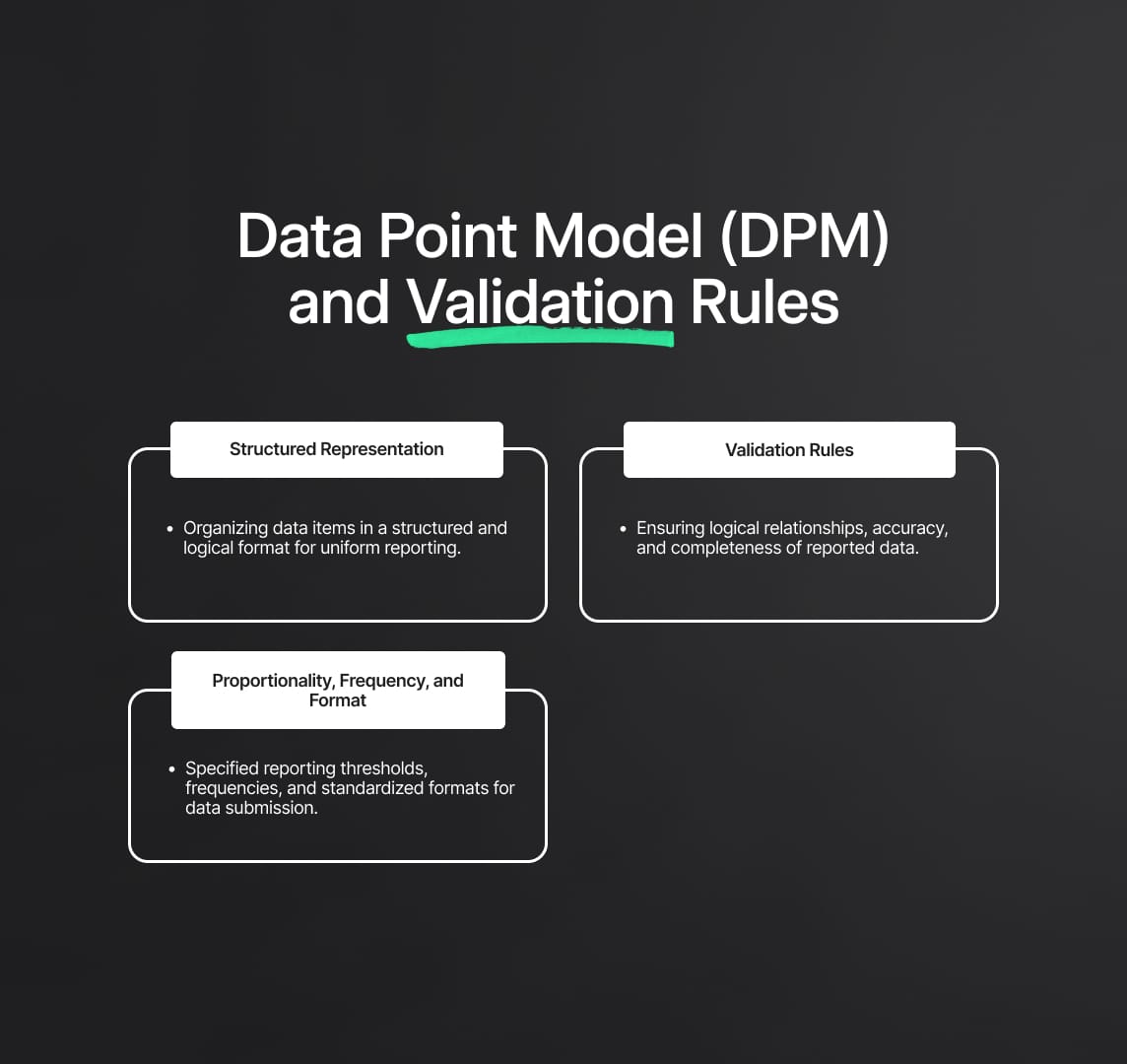
Validation Rules
Validation rules are essential for ensuring the integrity and reliability of the reported data. These rules are designed to check the logical consistency, accuracy, and completeness of the data, preventing errors and ensuring that the data meets the required standards.
Key Criteria for Validation Rules
- Logical Relationships: Validation rules define the logical relationships between relevant data points. This ensures that the data reported is coherent and makes logical sense within the context of the reporting framework.
- Filters and Preconditions: Validation rules include filters and preconditions that define the specific data sets to which the rules apply. This ensures that validation checks are relevant and appropriately targeted.
- Consistency Checks: Validation rules perform consistency checks to ensure that data points are consistently reported across different reports and time periods. This helps in maintaining the reliability and comparability of data.
- Accuracy Checks: Validation rules ensure the accuracy of reported data by checking for errors, omissions, and inconsistencies. This helps in maintaining the quality and credibility of the data.
- Default Values: Validation rules set default values for data points where relevant information has not been reported. This ensures that missing data does not compromise the overall integrity of the data set.
Example of Validation Rules
- Logical Relationship Rule: Ensures that data points within a report logically relate to each other (e.g., the sum of individual transaction values equals the total transaction value).
- Filter Rule: Applies a filter to include only data points that meet specific criteria (e.g., transactions above a certain value).
- Consistency Check: Verifies that data points are consistently reported across different reports and time periods.
- Accuracy Check: Ensures that data points are accurately reported, free from errors or omissions.
- Default Value Rule: Provides a default value for a data point if no value has been reported (e.g., setting a missing value to zero).
Proportionality, Frequency, and Format
The EBA’s guidelines emphasize proportionality, ensuring that the reporting burden on issuers is manageable while still providing comprehensive data for regulatory oversight. Specific reporting thresholds, frequencies, and formats are outlined to achieve this balance.
Proportionality
- Threshold: Issuers with an issue value higher than EUR 100,000,000 are required to report specified data points. This threshold ensures that significant entities are subject to detailed reporting requirements while smaller entities are not overburdened.
- Frequency: Data reporting is required quarterly, with reference dates on 31 March, 30 June, 30 September, and 31 December. This frequency ensures timely and relevant data submission without imposing excessive reporting demands on issuers.
Format
- Standardized Formats: Data should be submitted in specified formats, respecting data point definitions and validation rules. Standardized formats facilitate consistent data collection and analysis across the EU.
- Data Point Definitions: Clear definitions of each data point ensure that all entities report data in a consistent and comparable manner.
- Validation Rules: Implementing the validation rules ensures that all submitted data is accurate and reliable, maintaining the integrity of the reporting framework.
Templates for Collecting Information from CASPs
Issuers must collect relevant data from CASPs to fulfill their reporting requirements. The guidelines provide detailed templates and instructions to ensure that data collection from CASPs is consistent and harmonized across the EU.
Implications for Stakeholders under MiCA Regulation
The MiCA Regulation (Regulation (EU) 2023/1114) brings significant changes and responsibilities for various stakeholders in the crypto-asset ecosystem. The implementation of the EBA’s comprehensive guidelines on data reporting will impact Competent Authorities (CAs), issuers of Asset-Referenced Tokens (ARTs) and E-Money Tokens (EMTs), the European Banking Authority (EBA), and Crypto-Asset Service Providers (CASPs). Understanding these implications is crucial for ensuring compliance and fostering a stable and transparent crypto-asset market.
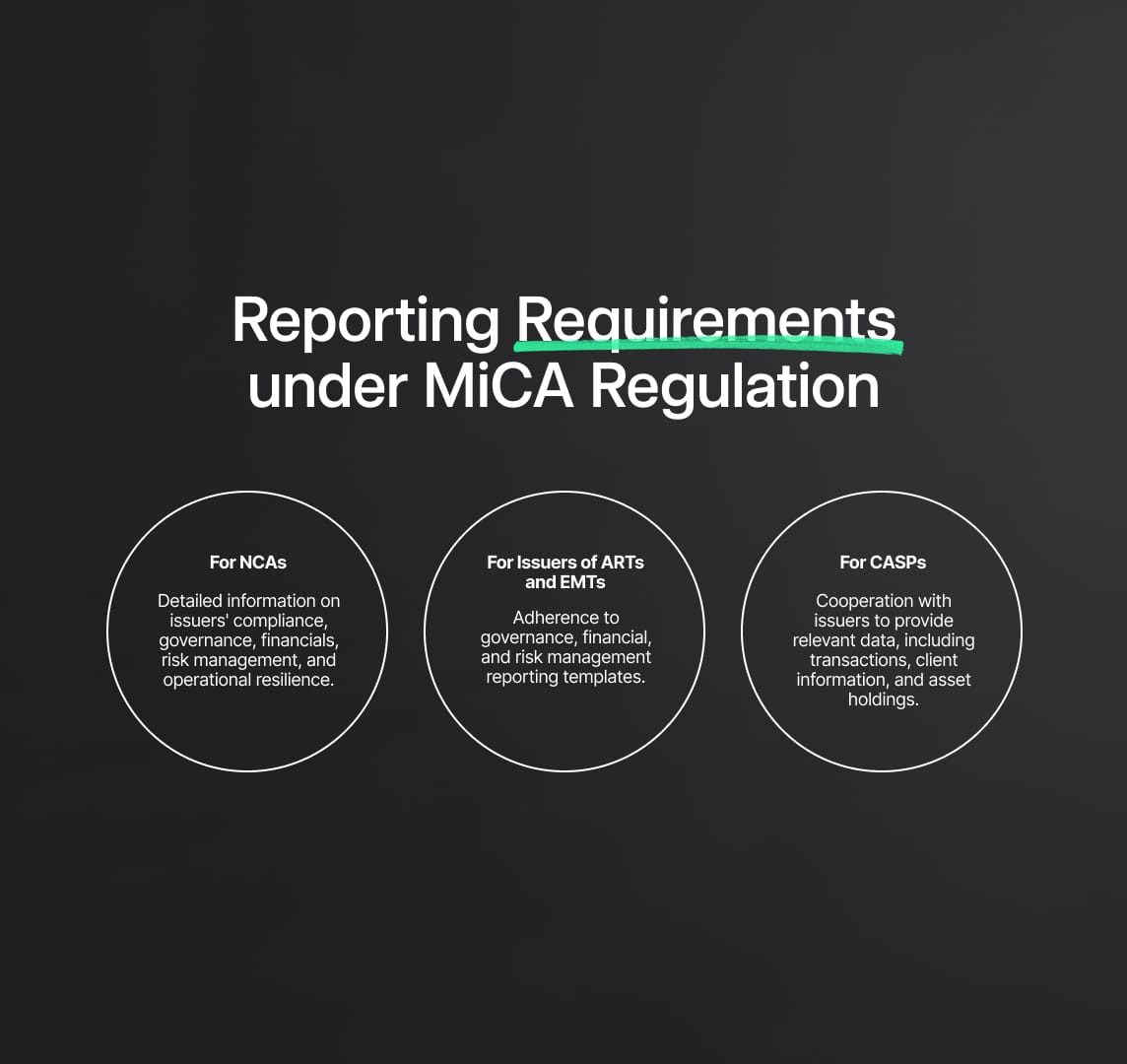
For Competent Authorities (CAs)
Competent Authorities (CAs) play a pivotal role in the supervision and enforcement of MiCA provisions. The implementation of the EBA’s guidelines will require CAs to enhance their data collection and reporting systems.
Key Requirements for CAs:
- Data Collection Systems: CAs must develop or upgrade their IT infrastructure to handle the detailed data reporting requirements specified by the EBA. This includes implementing systems capable of collecting, validating, and analyzing large volumes of data.
- Training and Capacity Building: Ensuring that CA staff are adequately trained to understand and implement the new reporting guidelines. This involves technical training on the use of the Data Point Model (DPM) and validation rules.
- Supervision and Enforcement: CAs will need to enhance their supervisory frameworks to monitor compliance with MiCA. This includes regular audits, inspections, and the ability to take enforcement actions against non-compliant entities.
Benefits for CAs:
- Improved Supervision: Enhanced data collection and reporting systems will enable CAs to supervise issuers and CASPs more effectively, ensuring adherence to MiCA regulations.
- Data-Driven Decision Making: High-quality, consistent data will support better decision-making and risk assessment, contributing to a more stable and transparent market.
For Issuers of ARTs and EMTs
Issuers of Asset-Referenced Tokens (ARTs) and E-Money Tokens (EMTs) must comply with the detailed reporting requirements set out by NCAs. This may involve significant changes to their data management and reporting processes.
Key Requirements for Issuers:
- Robust Data Management Systems: Issuers must invest in advanced data management systems to ensure accurate and timely reporting of required data points. This includes systems for financial reporting, risk management, and governance.
- Compliance with Reporting Templates: Issuers must adhere to the standardized templates and formats specified by the EBA for reporting data. This ensures consistency and comparability of data across different Member States.
- Regular Reporting: Compliance with the specified reporting frequencies, including quarterly submissions and additional reporting requirements as needed. Issuers must also be prepared to provide additional information for significance assessments.
Benefits for Issuers:
- Enhanced Market Credibility: Compliance with MiCA’s robust reporting requirements enhances the credibility and transparency of issuers, fostering trust among investors and stakeholders.
- Risk Management: Detailed reporting on governance, financials, and risk management practices helps issuers identify and mitigate risks more effectively, contributing to their long-term stability.
For the European Banking Authority (EBA)
The EBA will play a central role in overseeing the implementation of MiCA and ensuring that the regulatory framework is effectively enforced across the EU.
Key Responsibilities for the EBA:
- Standardization and Oversight: The EBA will benefit from standardized and high-quality data, enabling it to perform its supervisory duties more effectively. The DPM and validation rules will ensure that data is accurate, consistent, and comparable.
- Regulatory Guidance and Support: Providing ongoing guidance and support to NCAs and issuers to ensure smooth implementation of the reporting guidelines. This includes clarifying reporting requirements and addressing any issues that arise during the implementation process.
- Continuous Improvement: Monitoring the effectiveness of the reporting guidelines and making necessary adjustments to improve the regulatory framework.
Benefits for the EBA:
- Enhanced Supervisory Capability: Access to high-quality, standardized data will enhance the EBA’s ability to supervise the crypto-asset market effectively, ensuring compliance with MiCA and contributing to financial stability.
- Data-Driven Policy Making: The availability of comprehensive and accurate data will support data-driven policy-making, enabling the EBA to address emerging risks and trends in the crypto-asset market.
For Crypto-Asset Service Providers (CASPs)
Crypto-Asset Service Providers (CASPs) must cooperate with issuers to provide relevant data required for compliance with MiCA’s reporting requirements. This collaboration is crucial for ensuring the completeness and accuracy of reported information.
Key Requirements for CASPs:
- Data Provision: CASPs must provide detailed information on transactions, client holdings, and operational activities to issuers. This includes data on the number and value of transactions, distributed ledger addresses, and client identification.
- Compliance with Reporting Standards: Ensuring that the data provided is accurate and conforms to the standardized templates and formats specified by the EBA. CASPs must implement robust data management practices to maintain data integrity.
- Operational Coordination: Coordinating with issuers to ensure timely and accurate data submission. This includes establishing clear communication channels and processes for data sharing.
Benefits for CASPs:
- Market Integrity and Trust: Compliance with MiCA’s reporting requirements enhances the integrity and transparency of CASPs, fostering trust among clients and regulators.
- Operational Efficiency: Implementing standardized data reporting practices can streamline CASPs’ operations, reducing administrative burdens and improving efficiency.
Consultation Process
The EBA has initiated a consultation process to gather feedback on the draft guidelines. Stakeholders, including CAs, issuers of ARTs and EMTs, CASPs, and other market participants, are encouraged to submit their comments. This collaborative approach ensures that the final guidelines are practical, comprehensive, and effective in achieving the objectives of MiCA.
How to Participate:
- Comments Submission: Stakeholders can submit comments via the EBA's consultation page by October 15, 2024. Providing detailed feedback on the draft guidelines will help refine and improve the regulatory framework.
- Public Hearing: The EBA will host a virtual public hearing on September 20, 2024, from 10:30 to 12:00 CET. Interested stakeholders must register by September 18, 2024. This hearing provides an opportunity for stakeholders to discuss the guidelines and address any concerns or suggestions.
- Publication of Contributions: All contributions received will be published post-consultation unless requested otherwise. This transparency ensures that all feedback is considered in the finalization of the guidelines.
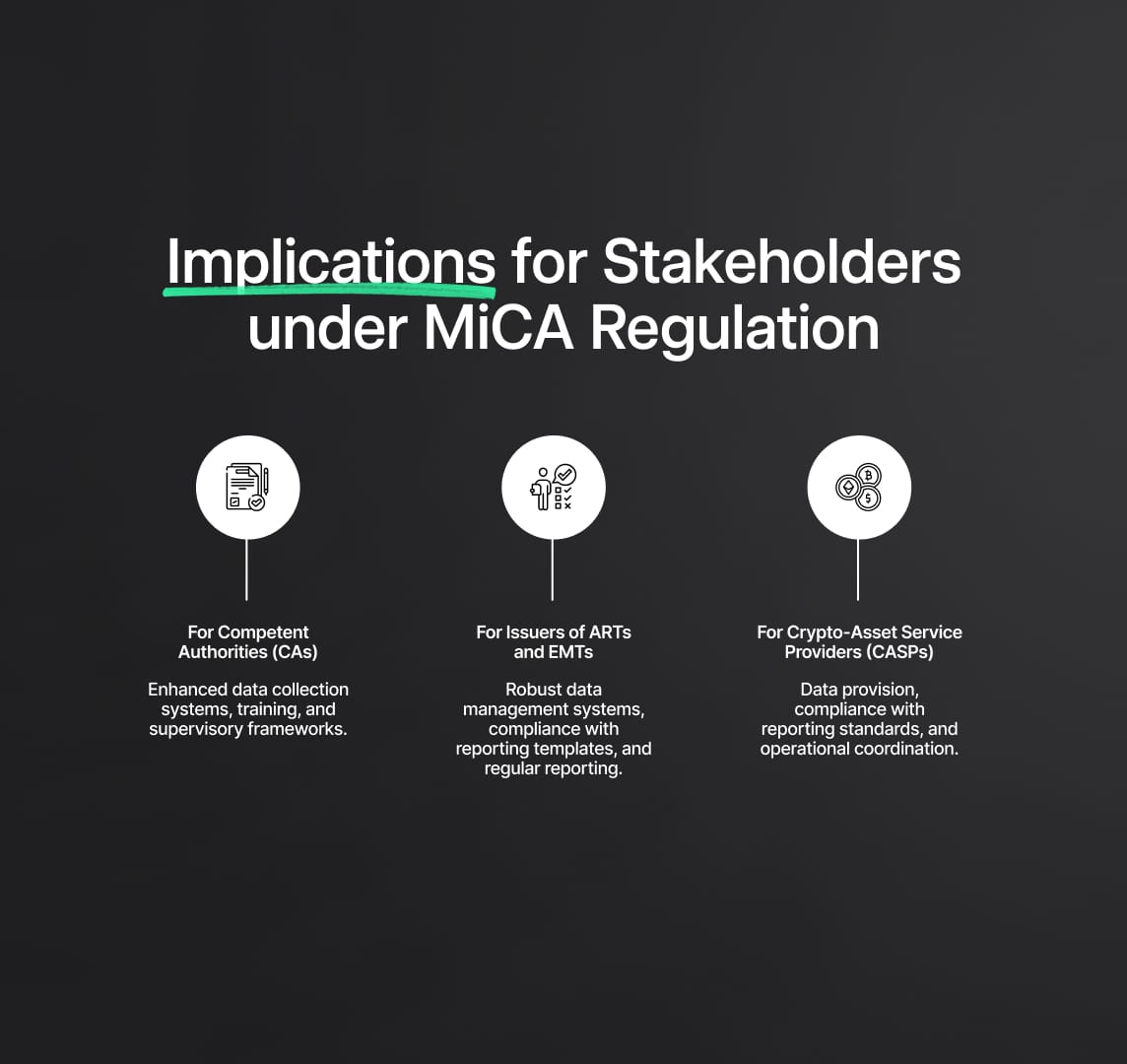
Reduce your
compliance risks


